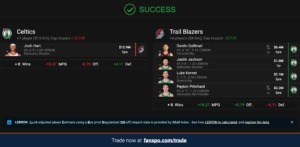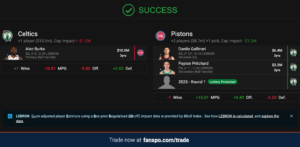Brad Stevens, Mike Zarren and Celtics executives followed the Celtics to Denver, Oklahoma City and Dallas. Boston dealt Noah Vonleh to San Antonio to clear a roster spot and $7-million in salary and luxury tax commitments before beating the Mavericks. They likely wanted to deliver the news themselves, the team posting a goodbye to the Haverhill native who successfully fought to make the team in training camp.
A similar move could follow with Justin Jackson, if the team wants to part with his salary before it becomes guaranteed for $2.1-million on Saturday. Luke Kornet, who secures the same money that day, will almost certainly remain with the team after proving himself as a reliable depth big man while Robert Williams III rehabbed. Blake Griffin’s solid play and Williams III’s return made Vonleh expendable. The difference, $50.2-million in luxury tax compared to $58.2-million if they retain Jackson, makes him worth watching too.
What happens after Saturday? The Celtics can play with 14 players indefinitely, but with 13 rostered players, they have two weeks from the day they hypothetically waive Jackson to add another.
They could do so with 10-day contracts, permitted as of this week, and Mfiondu Kabengele and J.D. Davison could fill any temporary availability needs before the trade deadline. Both haven’t played a fraction of the permitted time with Boston as two-way players.Carrying 13 players for now gives the Celtics the most roster and luxury tax flexibility possible to improve the roster into February.
Vonleh lost his role in the rotation and Jackson never entered it, and this roster has needs, however small. It remains doubtful Danilo Gallinari plays this season, and Sam Hauser’s effectiveness waned beginning in December. That leaves Jayson Tatum, Jaylen Brown and Malcolm Brogdon as probable playoff wings.
Trade Exceptions
Boston maintains a $6.9-million trade exception until Jan. 19, the date they traded Juancho Hernángomez last year, and $5.9-million until Feb. 10, the date of the Dennis Schröder deal. Those allow the Celtics to absorb salary outright into their empty roster spot. The cost would be $24.5-million in tax to use the full Schröder exception, and $28.8-million to use the Hernángomez extension.
Javonte Green ($1.8M) could easily slide into one of these with tax implication offset by sending out one player. He played well under Stevens, became close friends with Tatum and fits the team on both ends of the floor. Green wouldn’t arrive with expectations to supersede Hauser, and both could compete until the playoffs.
The biggest difficulty for the Celtics to make trades is their lack of a 2023 first-round pick, precluding them from trading their first in 2024. They’d need to offer a distant 2025 first-round pick to compensate trade partners.
Stacking salaries
The Celtics could explore consolidating salaries at the bottom of their roster to limit the cost of acquiring a significant salary, even at or below the TPE sizes. Danilo Gallinari ($6.5M), Payton Pritchard ($2.2M), Luke Kornet ($2.1M) and Jackson ($2.1M) give Boston $12.9-million in salary matching. That’s enough to acquire about $16.2-million in salary, which opens the door to a wide range of players. It falls to around $11-million without Kornet and Jackson, in case they keep the former and let the latter go.
Will Barton ($14.4M) could become available if the Wizards keep fading, an expiring contract who’d fit Boston’s five-out scheme. Doug McDermott ($13.75M) brings less versatility, more shooting and is signed through 2024. Kyle Kuzma ($13M) needs a contract extension, but could be the best player available. Josh Hart ($12.96M) falls into that same category. Kelly Olynyk ($12.8M) returns a familiar face for two seasons, Kelly Oubre ($12.6M) didn’t fit a similar Warriors system and is playing for his next deal.

That’s also the case with Jae Crowder ($10.2M), an intriguing, but potentially erratic option given his 2021-22 play and holdout over his bench role in Phoenix. Alec Burks ($10.0M) would help if only Pritchard and Gallinari exit, and Burks has a second-year player option. Detroit’s ample cap space this summer allows them to absorb Gallinari’s second-year player option more comfortably than many other teams.

The Vonleh trade showed big man depth isn’t as much of a concern as when the team reportedly eyed Jakob Poetl earlier this season. We explored TPE options during the offseason, which could be covered from a luxury tax standpoint by trading Gallinari and Pritchard.
10-day/free agent options
This becomes intriguing if the Celtics trade 2-4 players for one in the salary-stacking route. They’d then have to fill multiple roster spots internally or externally. They did this last year after trading Josh Richardson, Dennis Schröder, Romeo Langford, Bruno Fernando and Enes Freedom to receive Derrick White and Daniel Theis in separate deals. They signed Hauser and Kornet, along with Juwan Morgan, Nik Stauskas and Malik Fitts to fill out the roster. Matt Ryan joined the team in Hauser’s two-way spot.
On a team with a tight rotation, it’s not an exciting route, but it gave the team contracts to fit into the Malcolm Brogdon trade in July and Ryan fought hard for a training camp spot in Summer League before injuring his ankle. Hauser and Kornet became impactful rotation players after signing new contracts last offseason.
The G-League showcase and even Boston’s own roster contain some intriguing prospects, Luka Samanic making strides and winning a player of the month award. Mfiondu Kabengele and J.D. Davison could sign NBA deals later in the season, and continue to play for Maine through options. Denzel Valentine, who fought for a spot in training camp, also continues to play well in Maine. Ryan’s big performance against Maine notably drew Stevens’ attention last season before the trade deadline.
Veteran free agents seem less likely despite constant reminders Demarcus Cousin, Hassan Whiteside and other, most older big men, remain available. Tatum made a pitch for Kemba Walker, who the Mavericks waived yesterday. It’s hard to imagine a veteran who wants to play to continue their career joining Boston.
The most likely scenario is the Celtics keep their final roster spot open until the trade deadline, promote Kabengele if injuries and rest make his availability necessary, and decide what to do with it later. Realistically, the bottom of the roster doesn’t matter on a team that’ll court 8-9 players at most in the postseason.
The only captivating route would be the Celtics setting the groundwork now to consolidate the lower section of the roster for a bench upgrade. Especially as Hauser’s struggles continue and Brogdon’s injury history always puts him in question.

